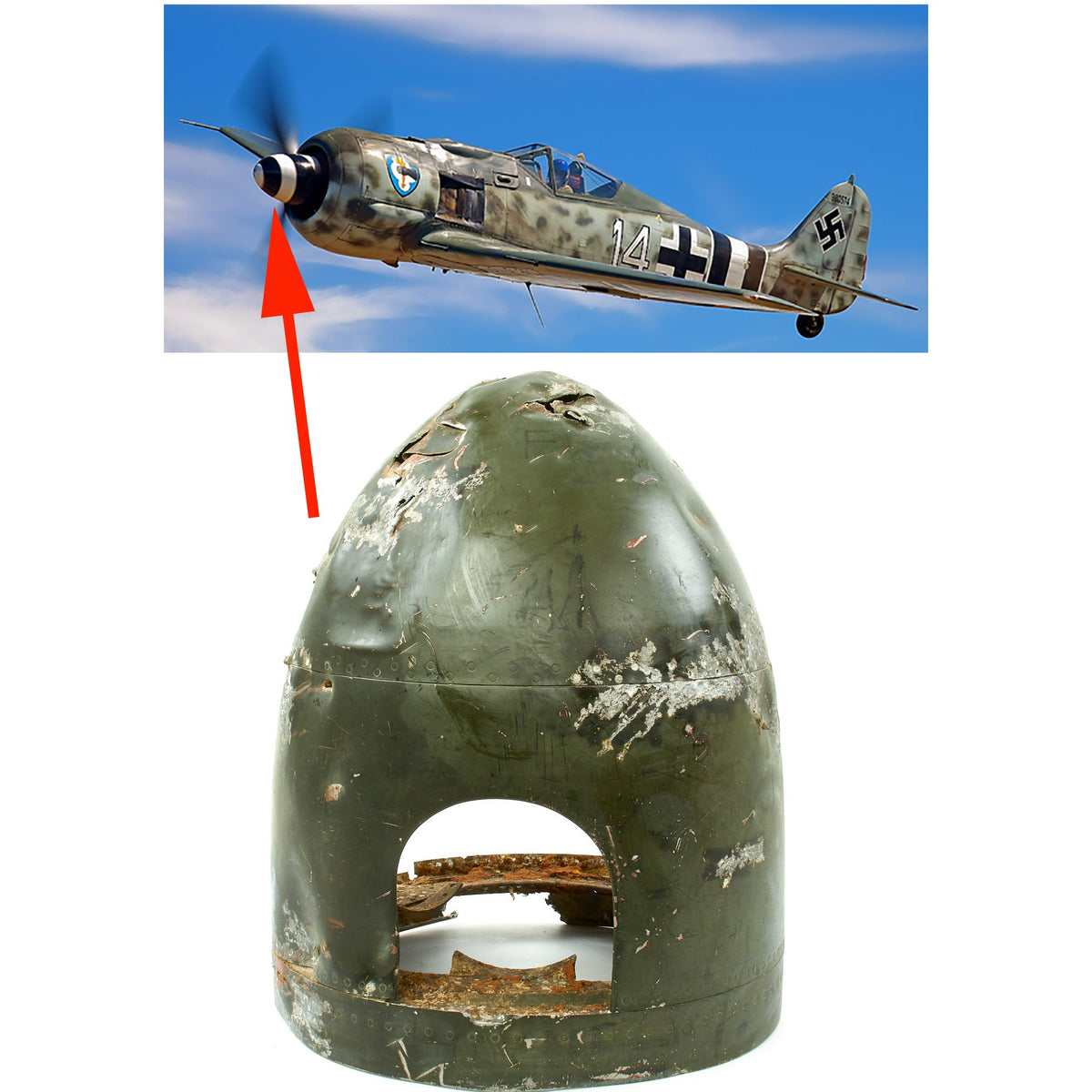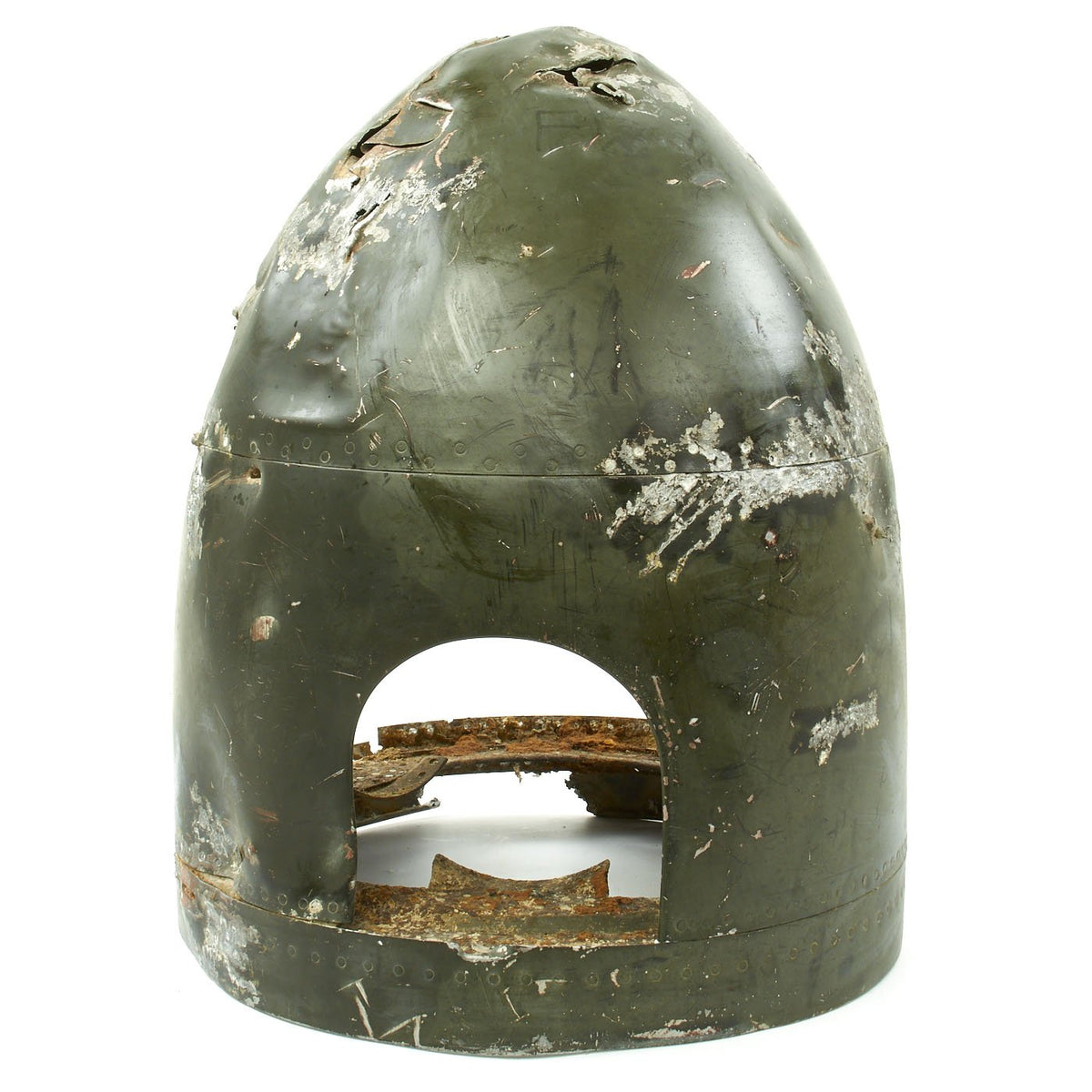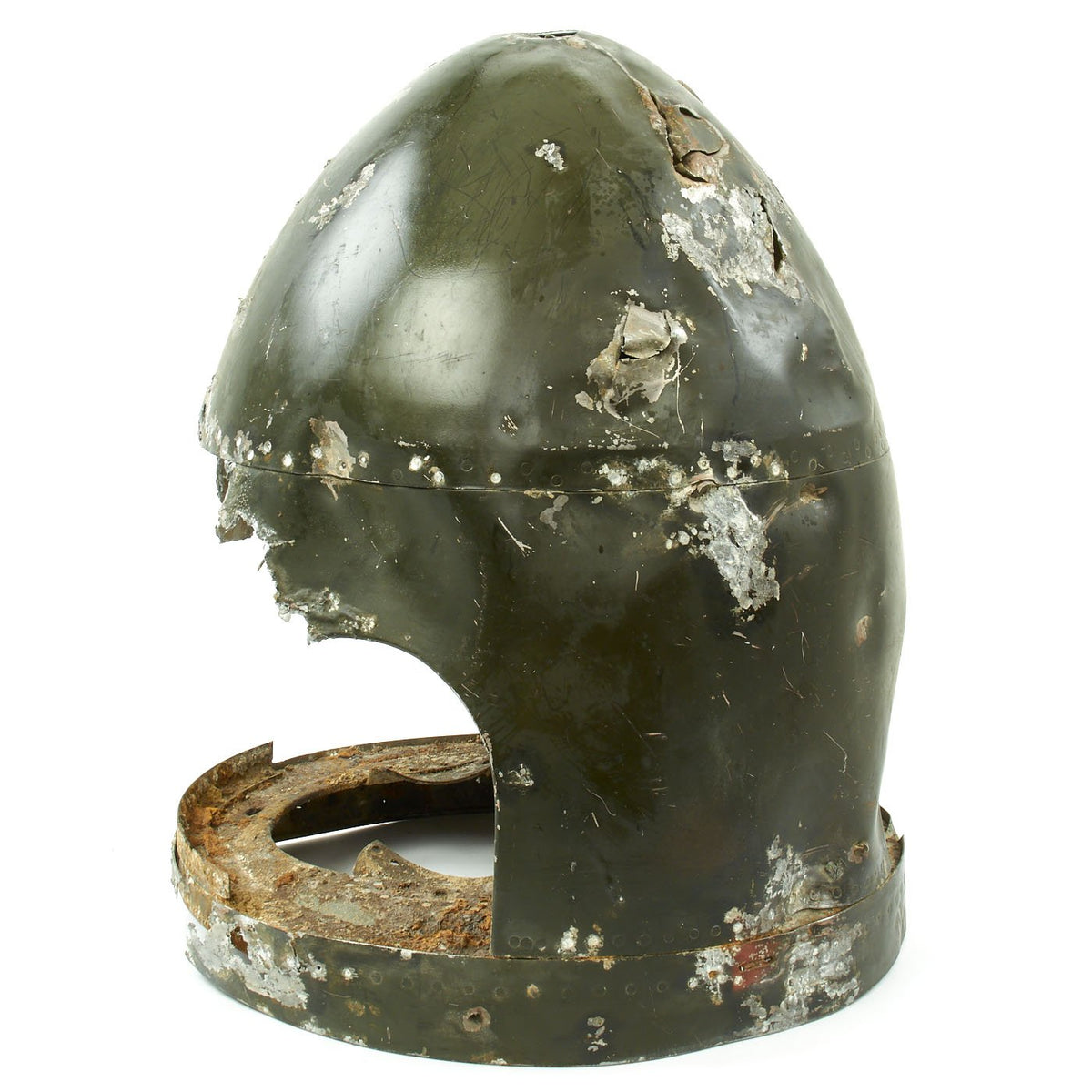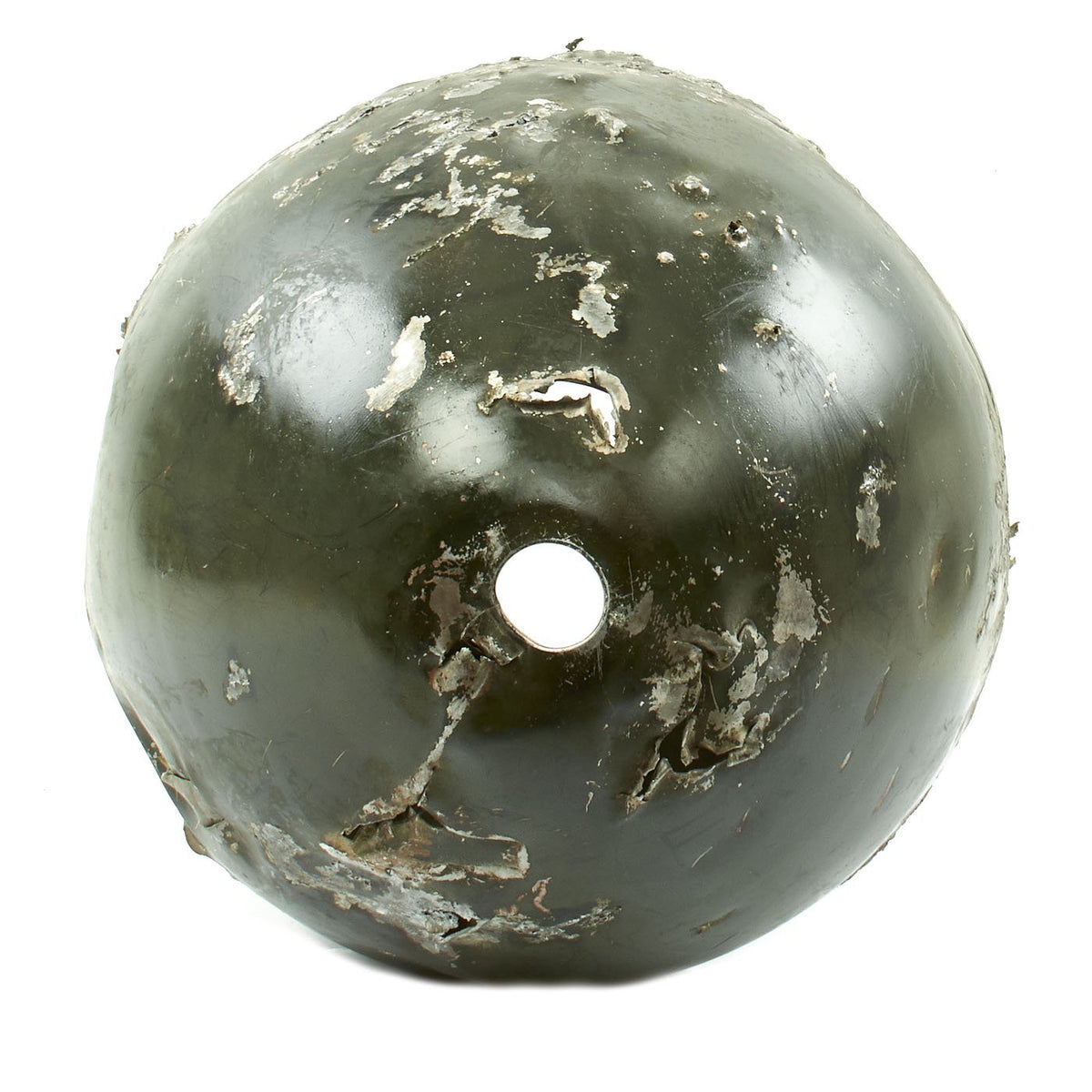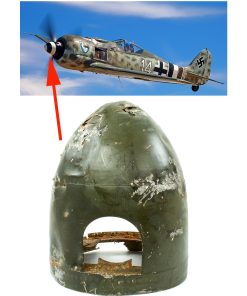Original German WWII Focke-Wulf Fw 190 Nose Cone Spinner – Jagdgeschwader 53 JG53 Original Items
$ 5.995,00 $ 1.498,75
Original Items: One-of-a-kind. This Focke-Wulf Fw 190 propellor spinner was recovered from a former airfield where the German WW2 Luftwaffe flight group Jagdgeschwader 53 (JG53). The spinner has multiple areas of damage which appear to have been from a crash. It is constructed to Aluminum and has all original paint. The interior is nicely in red paint stenciled lettering. It measures 27″ tall and has a 20.5″ diameter. it is a fascinating piece of World War Two German Aviation History. This is quite simply put; MUSEUM collection worthy.
The Focke-Wulf Fw 190 Würger (English: Shrike) is a German single-seat, single-engine fighter aircraft designed by Kurt Tank in the late 1930s and widely used during World War II. Along with its well-known counterpart, the Messerschmitt Bf 109, the Fw 190 became the backbone of the Luftwaffe’s Jagdwaffe (Fighter Force). The twin-row BMW 801 radial engine that powered most operational versions enabled the Fw 190 to lift larger loads than the Bf 109, allowing its use as a day fighter, fighter-bomber, ground-attack aircraft and, to a lesser degree, night fighter.
The Fw 190A started flying operationally over France in August 1941, and quickly proved superior in all but turn radius to the Royal Air Force’s main front-line fighter, the Spitfire Mk. V, In November/December 1942, the Fw 190 made its air combat debut on the Eastern Front, finding much success in fighter wings and specialised ground attack units called Schlachtgeschwader (Battle Wings or Strike Wings) from October 1943 onwards.
The Fw 190A series’ performance decreased at high altitudes (usually 6,000 m (20,000 ft) and above), which reduced its effectiveness as a high-altitude interceptor. From the Fw 190’s inception, there had been ongoing efforts to address this with a turbosupercharged BMW 801 in the B model, the much longer-nosed C model with efforts to also turbocharge its chosen Daimler-Benz DB 603 inverted V12 powerplant, and the similarly long-nosed D model with the Junkers Jumo 213. Problems with the turbocharger installations on the -B and -C subtypes meant only the D model entered service in September 1944. These high-altitude developments eventually led to the Focke-Wulf Ta 152, which was capable of extreme speeds at medium to high altitudes ( 755 km/h (408 kn; 469 mph) at 13,500 m (44,300 ft)). While these “long nose” 190 variants and the Ta 152 derivative especially gave the Germans parity with Allied opponents, they arrived too late to affect the outcome of the war.
The Fw 190 was well-liked by its pilots. Some of the Luftwaffe’s most successful fighter aces claimed many of their kills while flying it, including Otto Kittel, Walter Nowotny and Erich Rudorffer. The Fw 190 provided greater firepower than the Bf 109 and, at low to medium altitude, superior manoeuvrability, in the opinion of German pilots who flew both fighters. It was regarded as one of the best fighter planes of World War II
This Focke-Wulf Fw 190 propeller spinner was recovered from a former airfield where the German WW2 Luftwaffe flight group Jagdgeschwader 53 (JG53). The spinner has multiple areas of damage which appear to have been from a crash. It is constructed to Aluminum and has all original paint. The interior is nicely in red paint stenciled lettering. It measures 27″ tall and has a 20.5″ diameter. it is a fascinating piece of World War Two German Aviation History. This is quite simply put; MUSEUM collection worthy.
Jagdgeschwader 53 (JG 53) was a Luftwaffe fighter-wing of World War II. It operated in Western Europe and in the Mediterranean. Jagdgeschwader 53 – or as it was better known, the “Pik As” (Ace of Spades) Geschwader – was one of the oldest German fighter units of World War II with its origins going back to 1937. JG 53 flew the various models of the Messerschmitt Bf 109 throughout World War II.
Invasion of France; Battle of Britain
The Geschwader commenced its wartime operations with a high proportion of its personnel experienced ex-Condor Legion pilots including Werner Mölders. On 14 May 1940, JG 53 claimed some 43 victories in one day. The Battle of France thus saw the Geschwader score heavily during May and June 1940, with some 275 claims against Armee de l’Air and Royal Air Force forces. While JG 53 was making a reputation for itself during the Battle of Britain, according to RAF Air Ministry intelligence summary no. 60, Reichsmarschall Hermann Göring was informed that Major Hans-Jürgen von Cramon-Taubadel’s wife was Jewish. Göring then ordered the whole of Stabschwarm/JG 53.
Invasion of the Soviet Union
In April 1941 the Geschwader then transferred to the Eastern Front for Operation Barbarossa. Under the control of Luftflotte 2 commanded by Field Marshal Albert Kesselring, the Geschwader, now equipped with the Messerschmitt Bf 109F, flew operations from Warsaw-Bielany. On 31 July 1941 JG 53 shot down its 1,000th aircraft. In the period 22 June 1941 – 5 December 1941 JG 53 claimed to destroy 762 Soviet aircraft, losing 35 in aerial combat, and two on the ground.
Mediterranean Theatre
Later in the year JG 53 moved to bases in Sicily for operations against Malta (though elements also served in the Netherlands from July to November 1941). The III. Gruppe was transferred to North Africa for a short time in December 1941 while the rest of JG 53 was eventually moved to Comiso in Sicily for operations against Malta, which ended in May 1942. In the summer of 1942, II./JG 53 operated from the island of Pantelleria for operations over Malta and as escort missions for attacks on British supply convoys.
In May 1942 after the termination of the German air offensive against the British island fortress of Malta the “Pik As” Geschwader was split up, with its three Gruppen scattered over three theatres of operation. III./JG 53 again saw service in North Africa supporting Rommel’s planned advance on Cairo. Stab and II./JG 53 which were left behind on Sicily after the end of the “Malta Blitz” in May for service over the central Mediterranean, and I./JG 53 was moved to the Eastern front, where it was to take part in the German summer offensive in the southern sector aimed at Stalingrad and the Caucasus.
Battle of Stalingrad
Together with the JG 3 and JG 52, plus Stab and II./JG 77, I./JG 53 was deployed in Luftflotte 4’s 8th Air Corps to support Operation Blau. During the period May–September 1942 in the Eastern Front, I./JG 53 claimed 918 victories. It suffered the loss of 34 Bf 109s, 18 pilots killed in action and nine wounded.
During the Battle of Stalingrad, the I./JG 53 faced stiff resistance of the Soviet VVS and PVO both in the air and the ground, and several of the unit’s aces were shot down, wounded, captured or killed.
– 30 June 1942: A Yak-1 fighter shot down Leutnant Joachim Louis’s Messerschmitt Bf 109, who bailed out and became a POW. Louis had then 22 victories to his credit.
8 July 1942: Wilhelm Crinius (then an Unteroffizier with 12 air victories) was shot down by flak over Voronezh at 8:50 hs.
– 6 August 1942: Leutnant Hans Röhrig (flying Bf 109G-2 W.Nr 13480) is forced to bail out by a Yak-1 fighter, apparently flown by Soviet ace Starshiy Leytenant Mikhail Baranov (183 IAP, 269 IAD).
– 19 August 1942: Walter Zellot’s Bf 109 was shot-up by a Soviet fighter
– 7 September 1942: While escorting a Fw.189A-1 of 4.(H)/10, 10-victories ace Feldwebel Wilhelm Budke was caught by surprise by Soviet Yak-7B ace Amet-khan Sultan (4 IAP), and had to bail out of his Bf 109 G-2 W.Nr. 13680. Amet-Khan’s comrade ace Ivan Stepanenko shot up the Fw 189, which was damaged beyond repair (65%) and was scrapped.
– 8 September 1942: 38-victories ace Oberfeldwebel Hans Kornatz was downed and injured in air combat,
– 9 September 1942: 60-kills ace Leutnant Alfred Franke (flying a Bf 109, 2./JG 53) was downed in air combat by Ilyushin Il-2 Shturmovik pilot Pavel S. Vinogradov (694 IAP, 228 ShAD) and was killed in the crash.
– 10 September 1942: three I./JG 53 pilots were killed or wounded over Stalingrad: Unteroffizier Heinrich Wöhrle (10 victories, WIA), Feldwebel Franz Hagedorn (37 victories, killed by another Il-2 Shturmovik) and Leutnant Walter Zellot (86 victories), who was shot down and killed by flak.
– 13 September 1942: While escorting Ju 88s, 11-victories ace Unteroffizier Erwin Meier (2./JG 53) jumped the Yak-1 of female pilot Raisa Belyaeva. However, he was surprised by another Yak-1 flown by future leading female ace Lydia Litvyak and had to bail out of his flaming Bf 109 G-2. He became a POW.
North Africa
On 1 November 1942, Hauptmann “Tutti” Müller was appointed Gruppenkommandeur of I./JG 53 and led the unit back to the Mediterranean Theater. By November 1942 the entire wing was again concentrated on Sicily for an offensive against Malta, an abortive and short-lived blitz foiled by the defenders. During its 1942 operations over North Africa, Sicily and Malta JG 53 had claimed a total of 388 aircraft shot down. Hauptmann Gerhard Michalski claimed 25 over Malta. With the Allied invasion of French North Africa in November, the Geschwader again found its components separated.
“Defense of the Reich”
II./JG 53 was withdrawn from Italy in October 1943, and was the first squadron of the unit to be employed in the Defense of the Reich operations, stationed near Vienna from October 1943 to March 1944, before moving to south Western Germany. The winter of 1943/44 saw bitter fighting over Italy.
II./JG 53 was the sole squadron employed against the Allied Operation Overlord on 6 June 1944. The Luftwaffe fighter units in France suffered catastrophic losses, and II./JG 53 was no exception. In just one month of operations, the squadron reported 42 aircraft lost through enemy action, 18 in accidents, 20 abandoned and a further 20 through other causes; approximately 200% of its operational strength.
III./JG 53 also returned from Italy in June 1944 and after a short period refitting was active in operations against the Allied forces. When the Allies launched Operation Market Garden, both II. and III./JG53 took part. A new IV. Gruppe was added in the autumn of 1944.
I./JG53 was later moved to Romania to protect the oilfields of Ploiești and also saw further action in Hungary in late 1944 and early 1945 against the Red Army. It retreated into Czechoslovakia and Austria and was disbanded in April 1945. The rest of the unit was disbanded days before VE Day.
Fast Shipping with Professional Packaging
Thanks to our longstanding association with UPS FedEx DHL, and other major international carriers, we are able to provide a range of shipping options. Our warehouse staff is expertly trained and will wrap your products according to our exact and precise specifications. Prior to shipping, your goods will be thoroughly examined and securely secured. We ship to thousands clients each day across multiple countries. This shows how we're dedicated to be the largest retailer on the internet. Warehouses and distribution centres can be located throughout Europe as well as the USA.
Note: Orders with more than one item will be assigned a processing date depending on the item.
Before shipping before shipping, we'll conduct a thorough inspection of the items you have ordered. Today, the majority of orders will be delivered within 48 hours. The delivery time will be between 3-7 days.
Returns
The stock is dynamic and we cannot completely manage it because multiple stakeholders are involved, including our factory and warehouse. So the actual stock may alter at any time. It's possible that you may not receive your order once the order has been made.
Our policy is valid for a period of 30 days. If you don't receive the product within 30 days, we are not able to issue a refund or an exchange.
You can only return an item if it is unused and in the same state as the day you received it. You must have the item in its original packaging.
Related products
Uncategorized
Uncategorized
Uncategorized
Uncategorized
Uncategorized
Uncategorized
Uncategorized
Uncategorized
Uncategorized
Uncategorized
Uncategorized
Uncategorized
Uncategorized
Uncategorized
Uncategorized
Uncategorized
Armoured Fighting Vehicles of the World: AFVs of World War One (Hardcover Book) New Made Items
Uncategorized
Uncategorized
